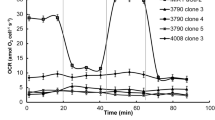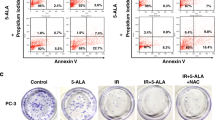Abstract
We have shown that addition of exogenous delta-aminolaevulinic acid (ALA) to rat pancreatoma AR4-2J cells in culture leads to the increased production of porphobilinogen (PBG) and the accumulation of photoactive protoporphyrin IX (PPix) in these cells. Exposure to light (lambda > 400 nm) at an intensity of 0.2 mW cm-2 for 8 min resulted in an ALA dose-dependent cytolysis of the cells, with an EC50 of 6.6 +/- 0.7 microM. This cytolytic effect was light intensity dependent, with greater cell destruction after exposure to light at an intensity of 0.47 mW cm-2 than at 0.2 mW cm-2; it was also dependent on the duration of illumination, cell survival decreasing with increasing illumination times. The photodestruction of the AR4-2J cells following exposure to ALA can be attributed to the production of endogenous PPix, a photoactive porphyrin that we have shown to generate singlet oxygen upon illumination, whereas ALA itself does not. Further investigation of the molecular mechanisms underlying the photodynamic action of ALA demonstrated the involvement of the mitochondrial (peripheral) benzodiazepine receptor (MBR), a high-affinity recognition site for dicarboxylic porphyrins, and especially PPix. The centrally acting benzodiazepine compounds clonazepam and flumazenil, which have negligible affinities for the MBR, had no effect on ALA-mediated phototoxicity. In contrast, both the isoquinoline carboxamide PK11195 and the benzodiazepine Ro 5-4864 ligands, displaying a high affinity for the MBR, did affect ALA-mediated phototoxicity, each markedly increasing the EC50 for cell photodestruction and thus exerting a photoprotective effect. It is concluded that the MBR may play an important role in the expression of ALA-mediated PPix phototoxicity and that MBR ligands, by diminishing the actions of endogenous PPix, have the potential to rescue cells from porphyrin-induced photolysis.
This is a preview of subscription content, access via your institution
Access options
Subscribe to this journal
Receive 24 print issues and online access
$259.00 per year
only $10.79 per issue
Buy this article
- Purchase on Springer Link
- Instant access to full article PDF
Prices may be subject to local taxes which are calculated during checkout
Similar content being viewed by others

Author information
Authors and Affiliations
Rights and permissions
About this article
Cite this article
Ratcliffe, S., Matthews, E. Modification of the photodynamic action of δ-aminolaevulinic acid (ALA) on rat pancreatoma cells by mitochondrial benzodiazepine receptor ligands. Br J Cancer 71, 300–305 (1995). https://doi.org/10.1038/bjc.1995.60
Issue Date:
DOI: https://doi.org/10.1038/bjc.1995.60
This article is cited by
-
Effect of DTPP-mediated photodynamic therapy on cell morphology, viability, cell cycle, and cytotoxicity in a murine lung adenocarcinoma cell line
Lasers in Medical Science (2015)
-
Antiproliferative effect of peripheral benzodiazepine receptor antagonist PK11195 in rat mammary tumor cells
Molecular and Cellular Biochemistry (2010)
-
Photodynamic Tumor Therapy: Mitochondrial Benzodiazepine Receptors as a Therapeutic Target
Molecular Medicine (1998)


